MANIFESTA 12
The Twelfth Edition of the European Nomadic Biennial Celebrates The City of Palermo, Sicily

Every two years, the nomadic art biennale Manifesta, explores a new city in Europe, highlighting the existing cultural landscape with commissioned artworks responding to their environment, geographical location and current social movements. Selecting cities which reflect the historical and current changes existing within Europe’s DNA, previous biennale’s have been held in Rotterdam, San Sebastian, Limburg and Zurich amongst others. This year, Palermo – also the Italian Capital of Culture for 2018 – was selected for its unparalleled diversity.
For the 12th edition, Manifesta enlisted four creative mediators to plan the biennale programs: Ippolito Pestellini Laparelli (OMA partner, also born in Sicily), Bregtje van der Haak (a Dutch filmmaker and journalist), Andrés Jaque (a Spanish architect and scholar based in New York) and Mirjam Varadinis (a Swiss contemporary art curator). Multiple viewpoints and voices have been brought together by the curators to create a diverse program, and commissioned works by more than 50 artists and practitioners are presented across 20 venues.
Palermo has constantly experienced continued migration due to its geographical location: a small island with a well-positioned port and a long history of conquer and rule. From the Ancient Greeks, the Arabs and the Normans, to the recent arrivals from North Africa, Southeast Asia and the Middle East, Palermo has always been a constant melting pot, of new inhabitants adding to its original and unique tapestry. What could be more fitting for a roaming biennale than to land in Palermo, a city built on this constant movement. The choice couldn’t have been more fitting for the current social and political climate, too. Days before the Manifesta 12 opening, the Italian government closed the country’s ports to refugee rescue boats (with The Aquarius, a ship with 629 migrant aboard, turned away from Italy at the last moment). Emphasised by Palermo’s Mayor Leoluca Orlando, in his city “there are no migrants, who arrives in Palermo becomes a Palermitan”. The current political shift in Italy does challenge this notion, with a new government closing borders instead of opening them. Mayor Orlando confirms that “culture is the coexistence of diversity”. And without diversity, where is the progression of a society? Since its incarnation in 1996, Manifesta’s philosophy remains to ‘seek fresh and fertile terrain for the mapping of a new cultural topography’. Founder and director of Manifesta, Hedwig Fijen, selected four creative mediators who, together with Fijen, curated the multi-layered and multi-disciplinary program under the guide of Manifesta 12’s theme The Planetary Garden: Cultivating Coexistence. Over 50 exhibiting artists, both international and Italian, presented commissioned works in run-down palaces and historical locations re-opened and activated through Dutch architecture firm OMA’s pre-biennale exploration.
For the first time, Manifesta have invited an architectural firm to survey the city before programming, using initial research to inform their overall approach, resulting in the Palermo Atlas. Led by Ippolito Pestellini Laparelli, OMA partner and who is also Sicilian-born, this may have been one of the most pivotal moments for the biennale. Laparelli’s intense investigation into the city’s landscape has taken into consideration short and long term impact for the local inhabitants, also ensuring they are involved to ensure a sense of community remains. Opening the doors to previously run-down palazzo’s and closed doors to historic buildings, the city and its spaces have been activated.
There is a lot to explore: venues range from long‐neglected palaces to Palermo’s fresh and lush botanical garden. Cooking Sections, a duo from London who explore the systems that organise the world through food, have created an installation exploring Sicily’s dry watering techniques that have made cultivation possible without irrigation systems. Their project, What is above is what is below, is a series of installations and packed lunches held at the back of Volpe Astuta. Along with Cooking Sections’ project, highlights of the programming have been panel discussions in the Teatro Garibaldi (Manifesta 12 headquarters) titled ‘Borderless: Imagining a Borderless Future?’ and the programming in the breathtaking Teatro Massimo where modern operas take place such as the Bintou Wéré: A Sahel Opera production. A tale of young West Africans who seek a better life in Europe, the story is sung from an African perspective, and the Manifesta team especially invited Wasis Diop to reinvent the opera for today’s Palermo.
The exploration doesn’t end there. Belgian collective Rotor, have intrigued visitors to explore the cliffs of Pizzo Sella on the northern coast of Palermo, 20 minutes outside of the central happenings. They have created a workshop, an urban intervention and an installation, titled Da quassù è tutta un/altra cosa, whereby they highlighted the city, the hills’ historical importance and the relationship between man and landscape. Pizzo Sella is renowned for the unfinished buildings (or moreso, unauthorised building and mafia involvement) baring raw concrete structures which dot the hillside, and can be seen from Mondello beach down below. It evokes extreme curiosity and Rotor collective invite you up to the hills to explore.
Also 30 minutes outside of Palermo central on its outskirts, the Coloco and Gilles Clément, Becoming a Garden takes visitors to the ZEN district. Infamous due to its living conditions and lower income inhabitants, the area is never visited by those whom do not live there, hence minimal integration of those who live in ZEN 1 or 2 with central Palermitans. The neighbourhood’s structure is completely unique and compelling. Constructed in 1969 under the design by Italian architect Vittoria Gregotti, the social housing is seen as a complete failure, contributing moreso to the creation of the economically deprived area. Dwelling isn’t idealistic and motivation for its existence a little dark, it was the circumstance of a city’s solution to its poorest inhabitants. Hence it’s location on the outskirts. There is only one bus route which links ZEN inhabitants to central Palermo. The population is around 16,000. The Becoming a Garden project has created a garden in ZEN 2 for inhabitants to enjoy and nourish, with aims of recreating a sense of community once again. It’s a start, and only time will tell what kind of commitment a project like this requires. Gilles’ Clement’s book ‘The Planetary Garden’ written in 2015 is the inspiration for the curatorial concept for Manifesta 12. Highlighting the ‘increasingly relevant metaphor of the planet as a garden and the need for humans to care for our spaces’.
Another influence and direct reference for the twelfth edition is Francesco Lojacono’s painting ‘Veduta di Palermo’ from 1875, visually portraying the vast diversity of flora in Palermo. Eucalyptus came from Australia, prickly pair from Mexico, loquat from Japan and aspen from the Middle East are pictured in the scene. To directly showcase this, the Palermo Orto Botanico (Palermo’s botanical gardens) is utilised to present to visitors first-hand the varied species of flora gathered, studied, nurtured and grown in harmony. It is a living, breathing, library. An archive of Palermo’s history. Various artist installations and studied are shown through different areas of the botanical gardens, but they only frame the natural wonders that have manifested and flourished there over time.
Not officially part of the twelfth edition of Manifesta, but communicated on their website and at their venues, is the Dreams in Progress tour to Gibellina Nuova. Organised by an anonymous artist, guerrilla of sorts, this tour is a much-needed addition to one’s overall view of Palermo’s – and in turn Sicily on whole – willingness to celebrate and promote art and architecture, and the importance of reflecting on history for a better future.
It’s true that Manifesta relies on the use of the chosen city’s cultural funding, allocated from city budgets which would otherwise go to local teams working long-term to oversee growth in the city’s arts sector, but we also see the importance of Manifesta’s fresh philosophy and outlook. From their position, they are able to bring a unique perspective on the city – one without pre-conceived notions – to local teams. The aim for Manifesta 12 is an open conversation with a focus on coexistence and – by emphasised by location – migration. The movement of people is ingrained in Sicily’s history, and as we know, there is always a lot we can learn from history for a better future in our current climate.

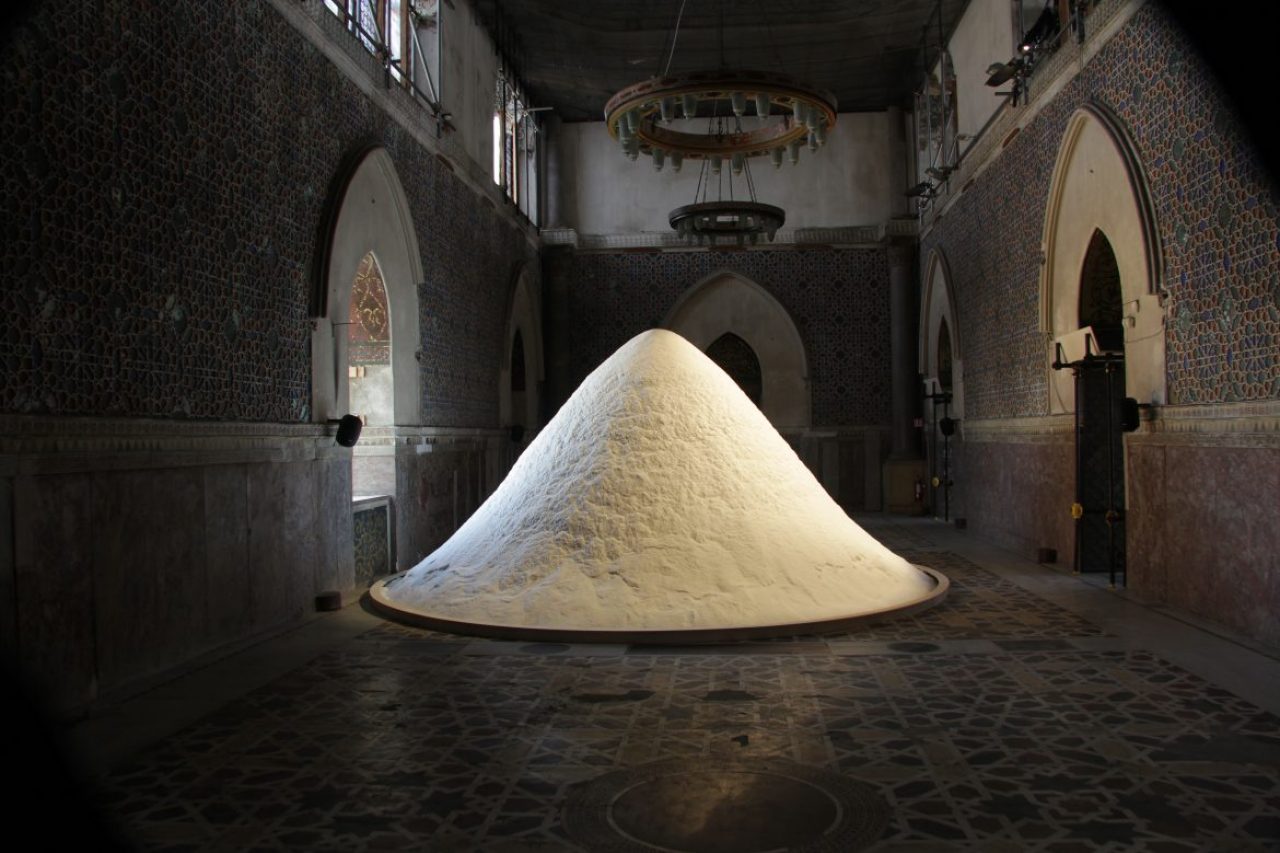
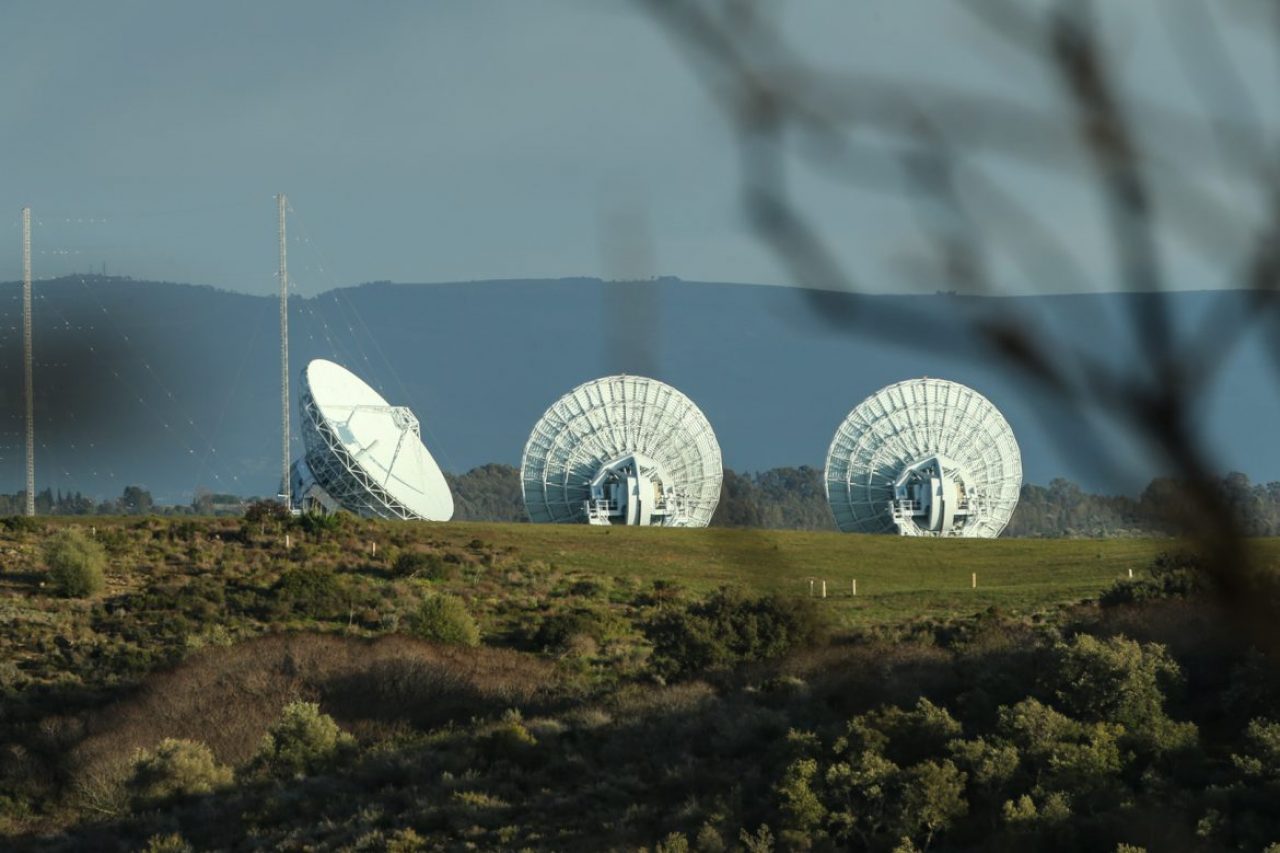

COOKING SECTIONS ‘What is above is what is below’
LOCATION: Volpe Astuta, via Micciulla, 1
Walk through the stunning ruins of the Volpe Astuta and you’ll arrive at a garden with a rectangular installation made up of terracotta brickwork. This is Cooking Sections’ ‘What is above is what is below’ project for Manifesta 12, and a physical example of their research into dry watering techniques used in Sicily to continue important cultivation in dry seasons. The duo from London (composed by Daniel Fernández Pascual and Alon Schwabe) work with visual art, architecture and geopolitical sciences in their artistic practice.
Their curiosity of Sicily’s irrigation systems was evoked due to the geographical location of the island: it is surrounded by water. Nature’s gifts are also of key importance to day-to-day life in Italy, so the Cooking Sections due began to ask questions such as ‘is there an actual lack of water?’ ‘Or is it a problem of water mismanaged?’ and ‘Who is taking advantage of resources?’. They found that control over water in Sicily gave origin to the first extortion structures in the 19th century. With underground qanāt tunnels to contemporary ad hoc pipes that bypasses the city’s infrastructure. Examining this system their installation is the physical form of their research on dry watering techniques that make possible cultivation without irrigation systems. On a volcanic enclave between the Tunisian and Sicilian coasts they found circular dry-stone walls enclosing single-tree garments, creating a microclimate for the plant and therefore allowing it to survive in harsh conditions.
The ingredients of their packed lunches are made up of drought-resistant ingredients: direct examples of Sicily’s key fruits and vegetables which outstand these conditions (through the help of ingenious inventions and now traditions).

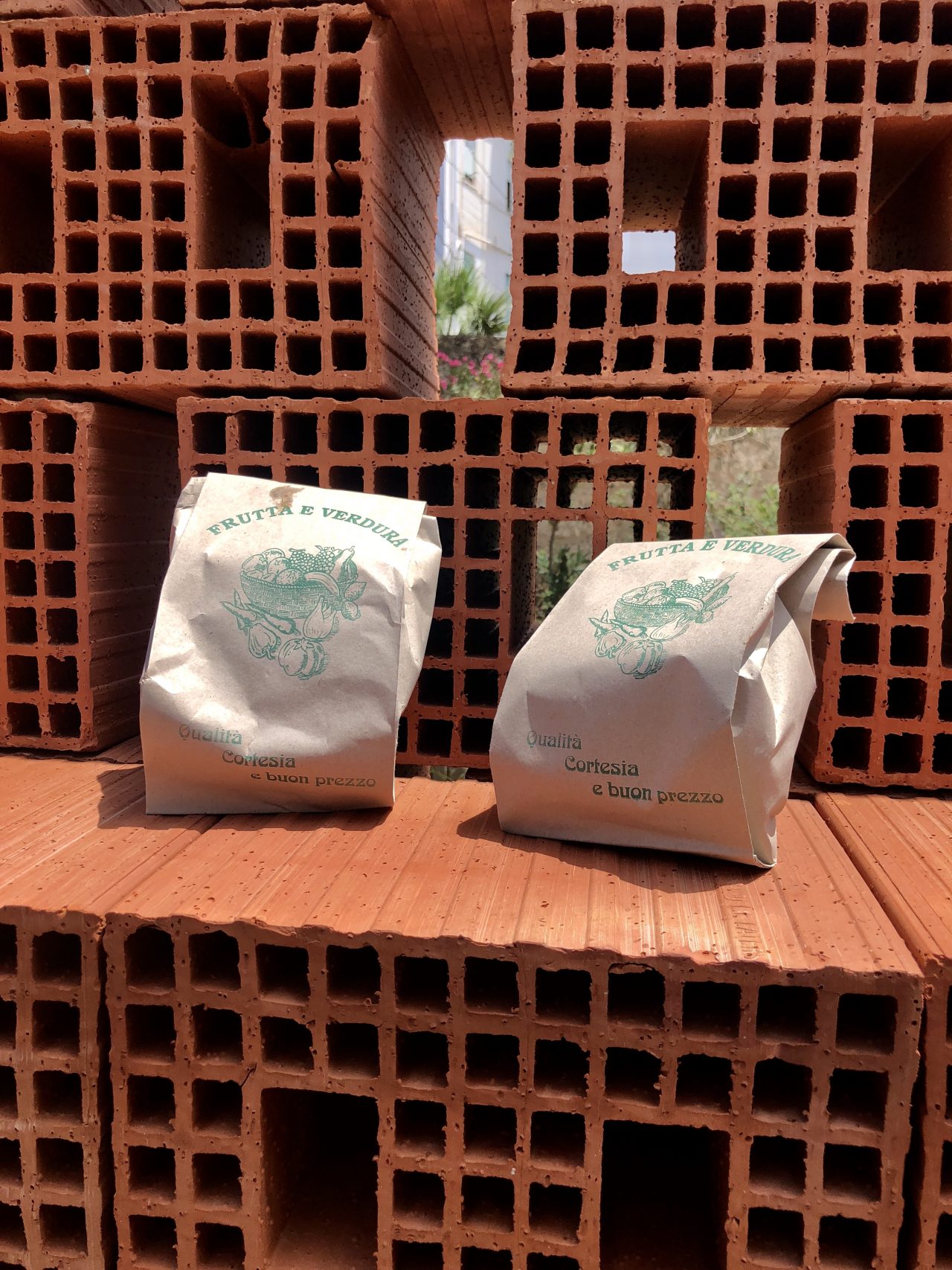
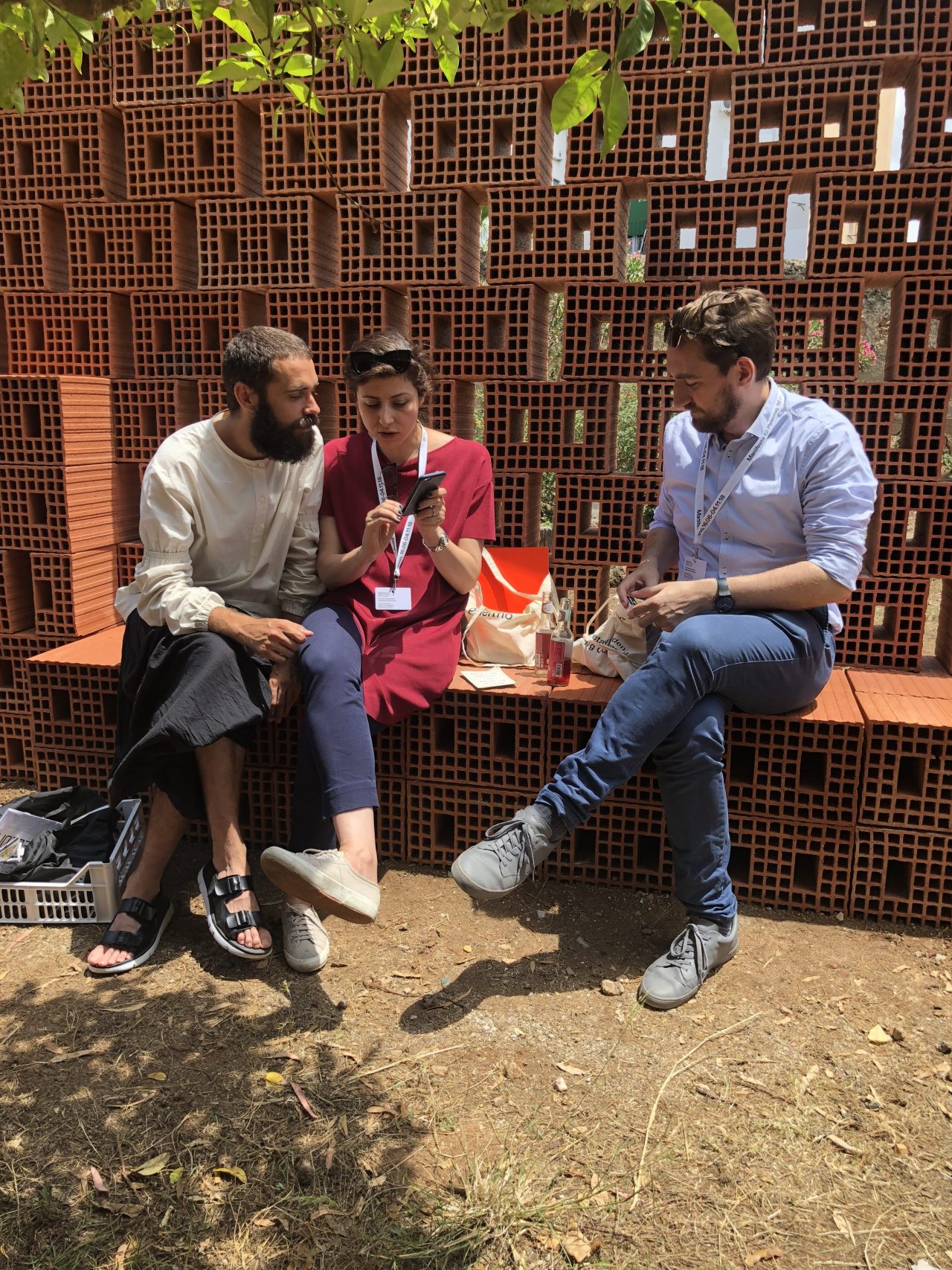
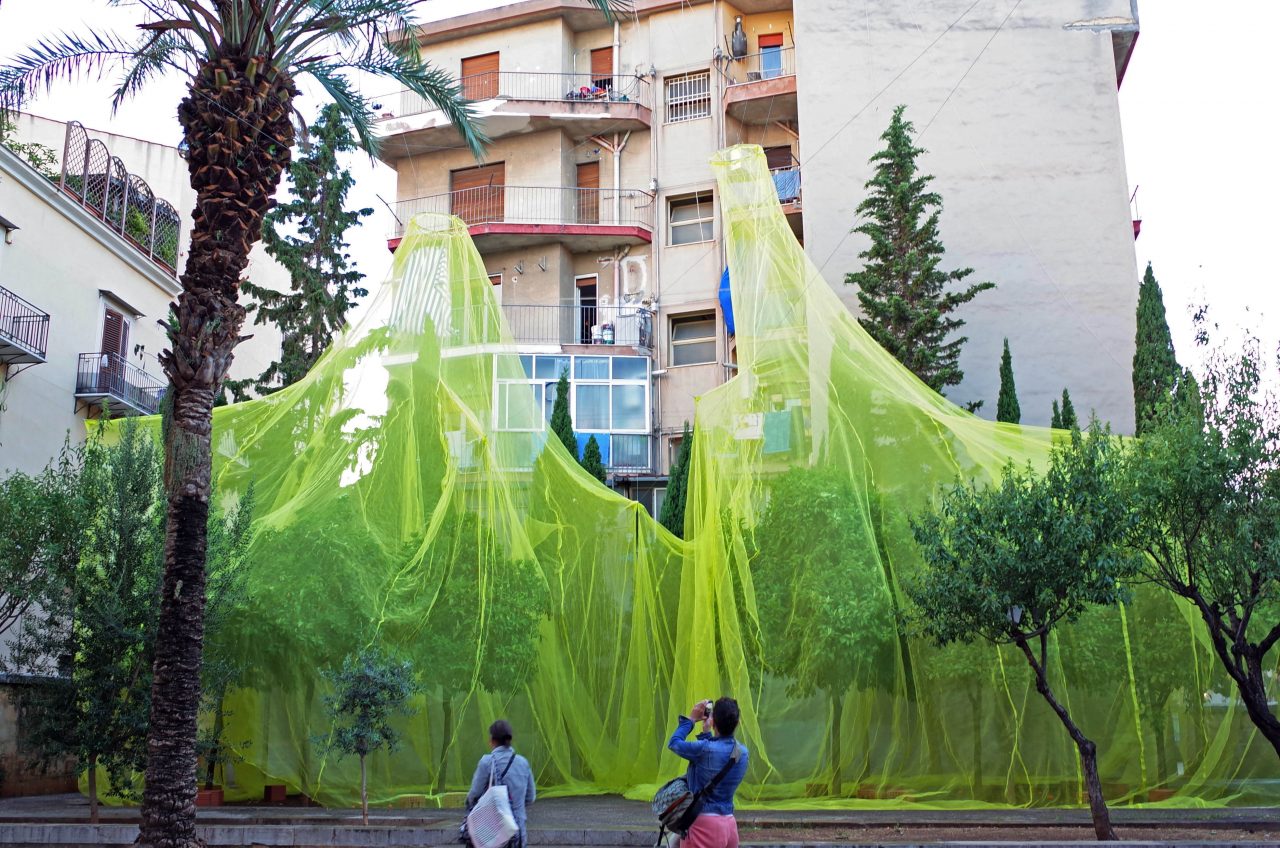
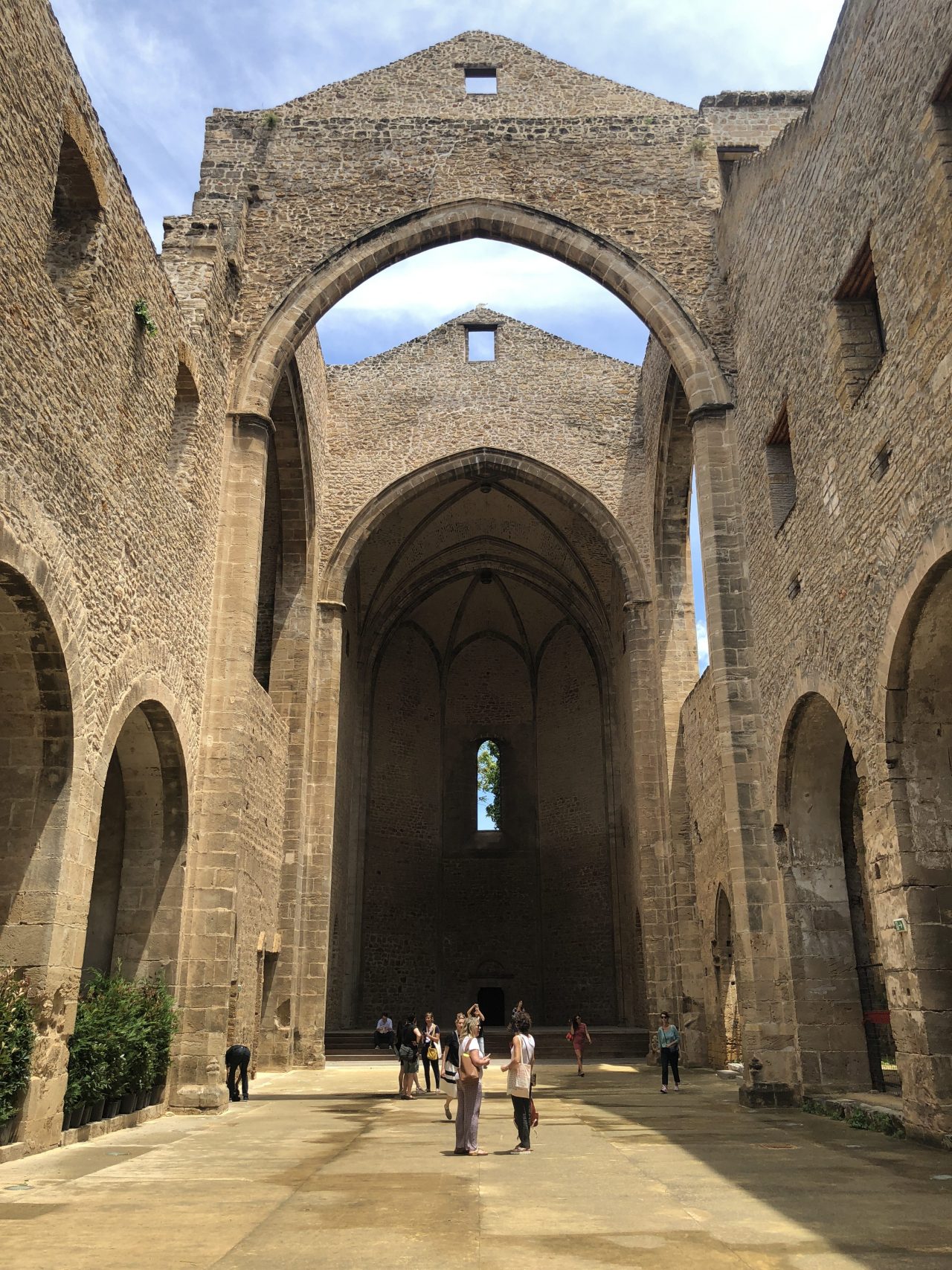
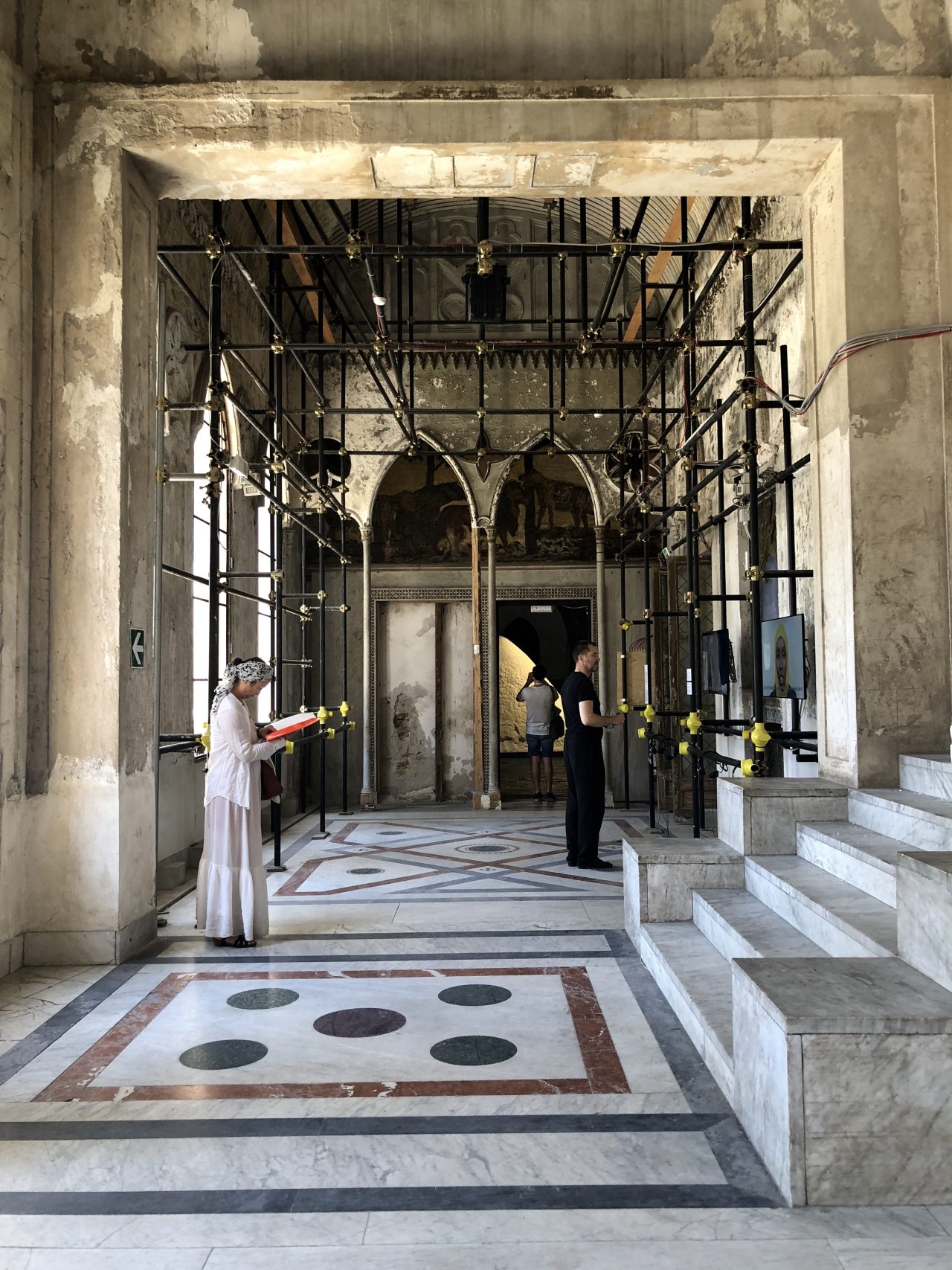
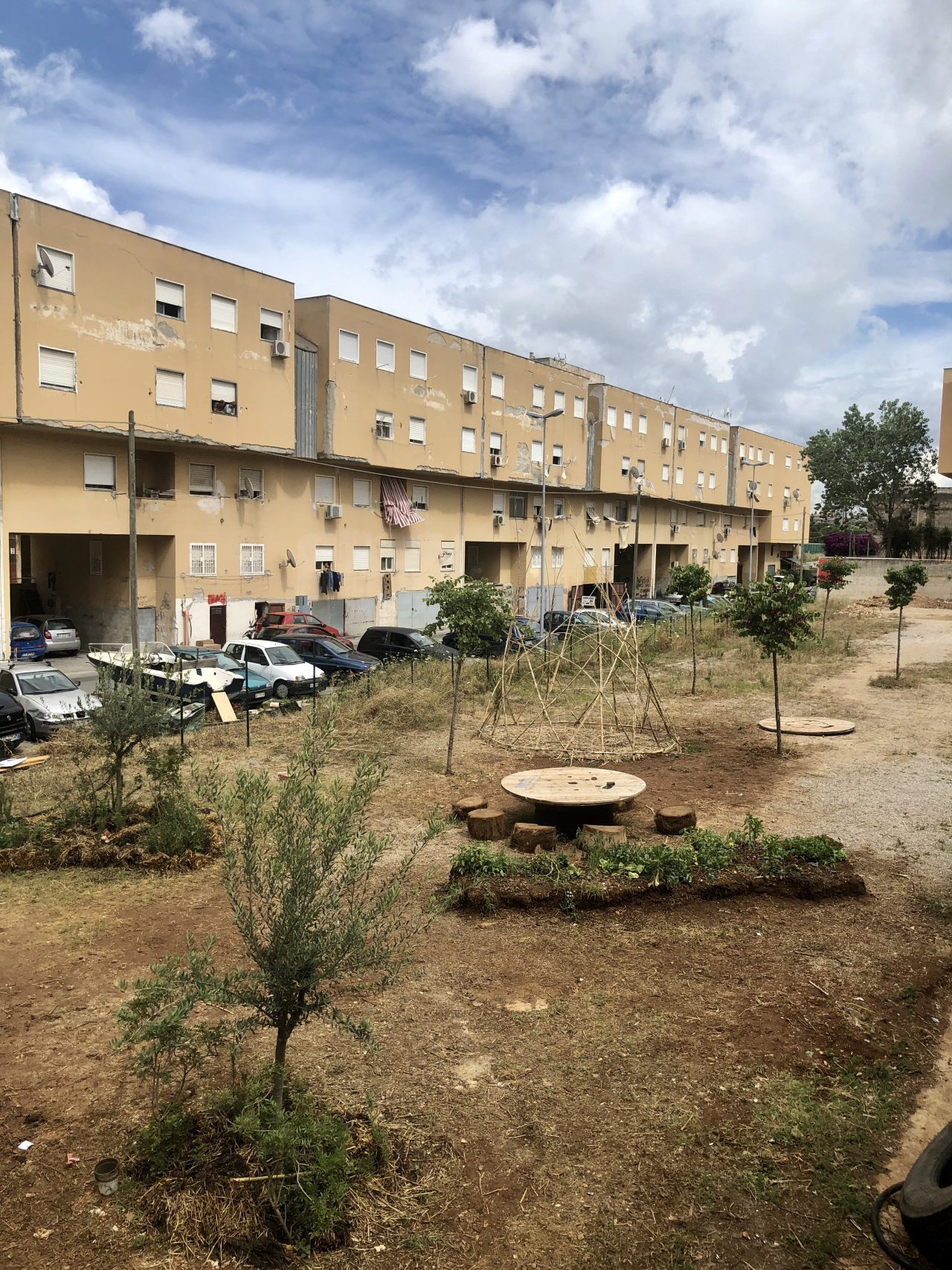
ROTOR ‘Da quassù è tutta un/altra cosa’
LOCATION: PIZZO SELLA
Belgian collective Rotor present the stunning peak of Pizzo Sella through a pathway of storytelling. Pizzo Sella, a promontory located between Mondello and Sferracavallo, can be seen from Mondello beach, where half-finished concrete buildings dot the hillside. The elements of economics and construction are primarily interesting here. In 1962 an urban planning incentive was stated by the government in response to a growing population of citizens. But between 1978 and 1983, about one million square metres of Pizzo Sella had been sectioned off and built on by a local construction company and after further investigation was found to be the result of a collaboration between the criminal world and municipal administration. Hurried building permits and illegal constructions resulted in several lawsuits and in 1997 the entire area was placed under preventive seizure. Speak to any Palermitan and they will describe it as the “Hill of Shame”, due to the mafia involvement building unauthorised buildings. 59 of 170 buildings are complete, and they adorn the hillside when seen from afar.
Rotor have created a path to the top of Pizzo Sella where amazing views of the cliffs, sea and city are on offer to present new perspectives. If you are lucky and it Is a semi-cloudy day, wind and sun with transform these clouds into moving paintings and create something truly breathtaking. Nature it seems, can still withstand exploitation.
Rotor’s project Da quassù è tutta un/altra cosa invites visitors to their workshop, urban intervention, installation and hike to the top of Pizzo Sella where nature reigns supreme over the hill’s history. Surrounded by Mount Biliemi in the south and Mount Pellegrino in the east, Pizzo Sella promontory is the highest peak in the area (562 meters).
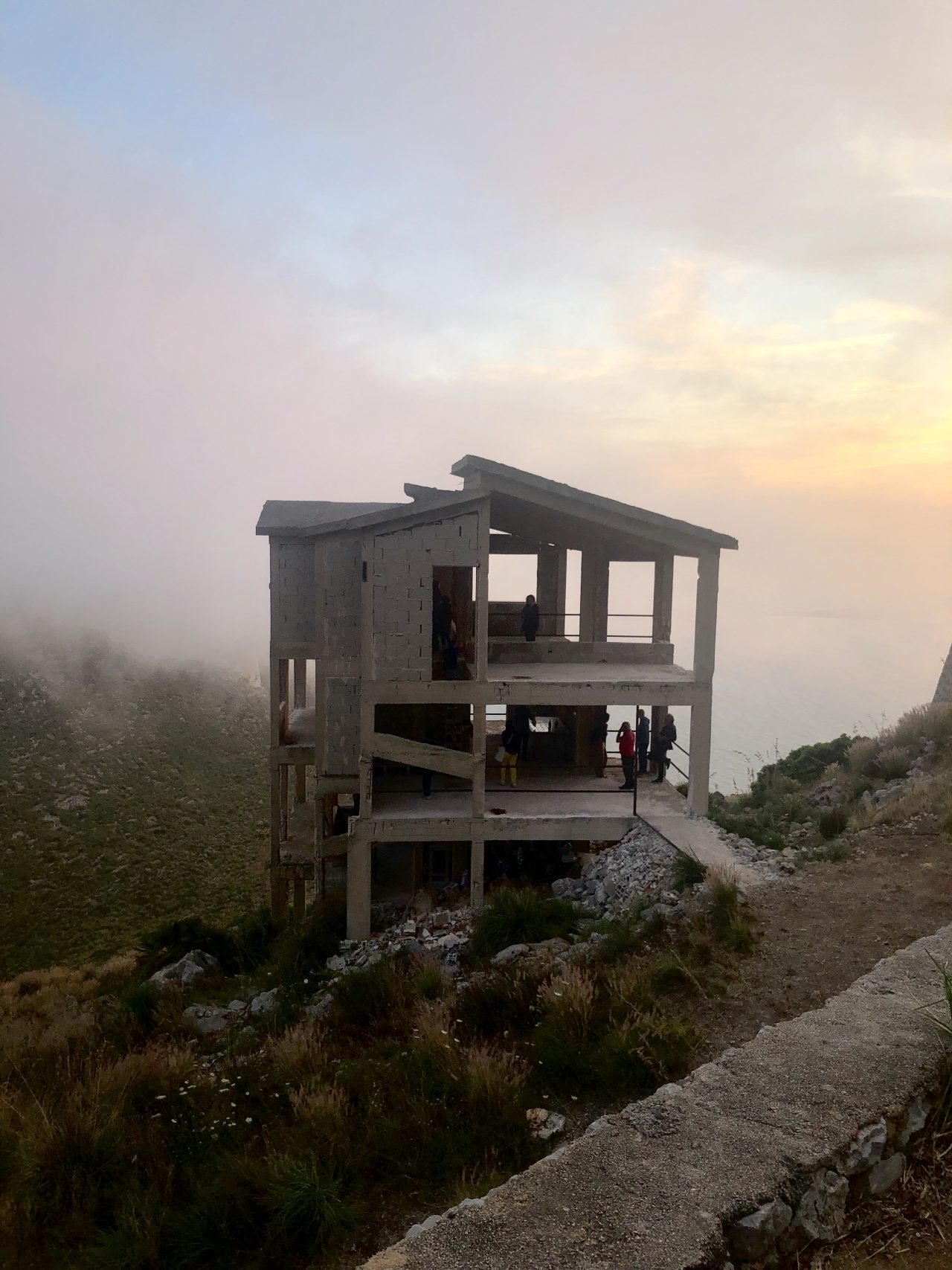
HOW TO GET TO THE BIENNALE
BOOK AHEAD
The biennale is currently ongoing until November the 4th, but book your flights and accommodation early. Peak months for Sicily are July and August, so you will also be battling tourists for the central locations in these months. Do your research. International flights go straight to Palermo Airport.
From Palermo airport there is an English-speaking counter which can advise on the best transport to the city, bus or taxi.
PLAN EACH DAY
• The biennale is extensive, so depending on how long you plan to stay in Palermo for, plan a realistic schedule corresponding to this. Allow for room to explore and allow for spontaneity.
• Check the Manifesta website for the various exhibiting artists and their projects.
• In Palermo, the Manifesta 12 headquarters (what they call their ‘Embassy’) is based in Teatro Garibaldi, and there you will find the Manifesta team ready to help with any queries, and next to them, a cafe open from morning to late.
There you can also pick up a printed map of Palermo, with the Manifesta sections and venues conveniently highlighted.
• It is possible to download the ‘My Art Map Palermo 2018’ application for the phone, but we found the printed map easier to use.
• Any questions also, just email us! We are always happy to give tips and more recommendations as needed.

Palermo, Italy
Until 4th of November 2018
_
Written by Monique Kawecki [Champ Editor-in-Chief]
Primary photography by Monique Kawecki on the iPhone X
Additional photography as credited

































